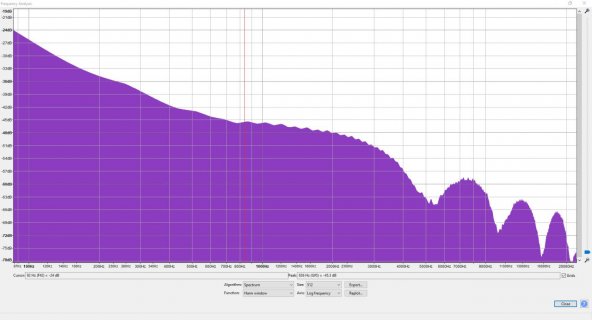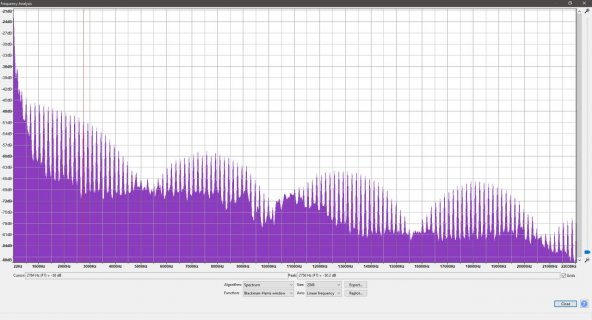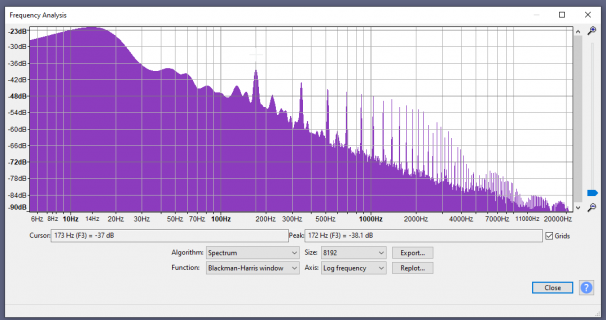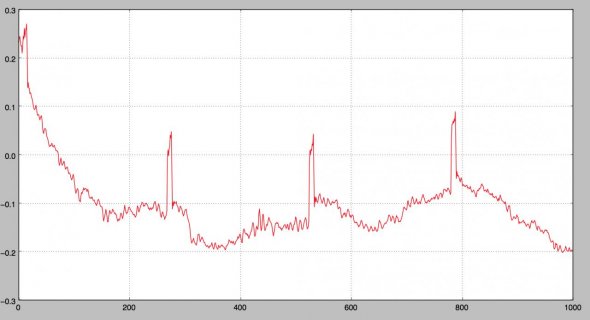Hello all,
I'm new to the Teensy ecosystem and like many others I am trying to get the audio guestbook project off the ground. I've got demos of many of the other basic building blocks of the project working, and am now working on a recording demo using the MIC/GND pins on my audio board. However, when I listen back to the recording I hear a high-pitched whine overlaid on the entire thing. I've attempted a few things to get rid of this behavior, including:
Components
Software
For the IDE, I am using Arduino 1.8.19. The board is configured as Teensy 4.0. To process audio files, I am using Audacity v3.2.5. The files are saved with the name .WAV, but are not WAV files. They can be imported into Audacity using File > Import > Raw Data and settings as shown in the following image:
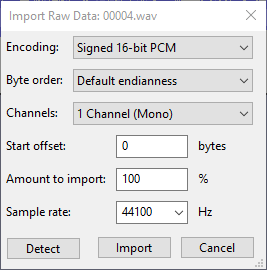
Hardware Setup
I have the Teensy 4.0 board soldered to the Teensy audio board. To the Audio board MIC pin, I have a white wire which goes to the positive side of my microphone. From the negative side of my microphone, I have a black wire which goes back to the Teensy audio board GND pin. Connected to the Audio board SD card slot is my Sandisk SD card, and I am receiving power to the Teensy micro USB port using my ferrite bead cable to my 5V battery pack.
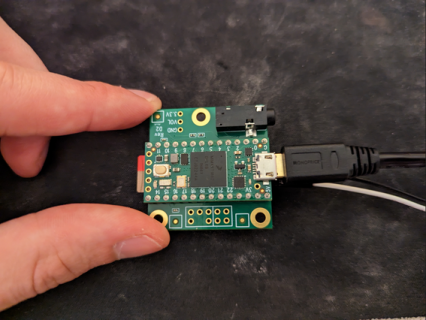
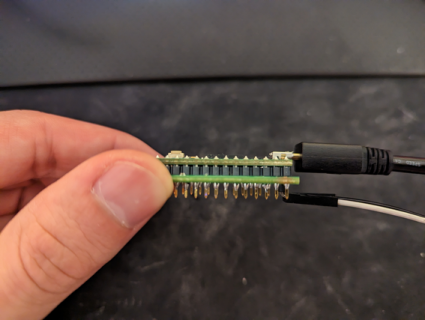
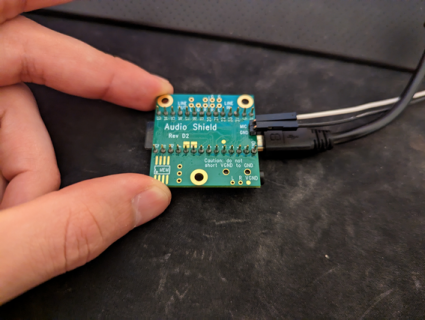
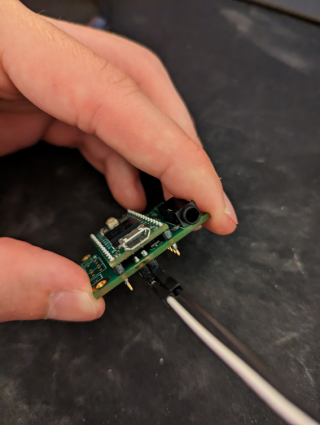
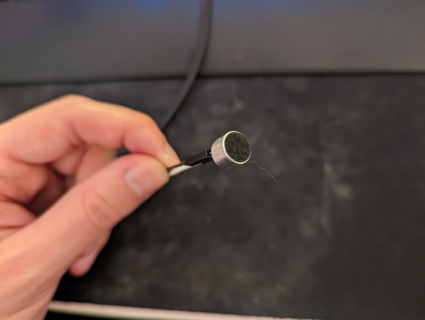
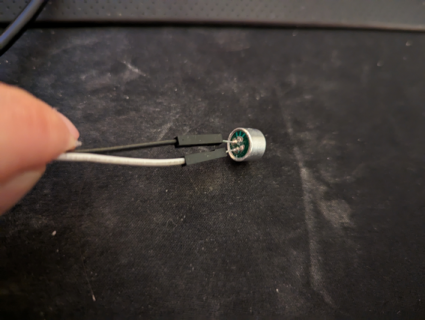
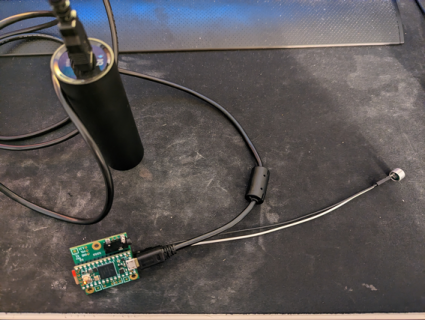
Result
I've uploaded a test recording to the following Google Drive Link. Note that it will not play on Google; it needs to be downloaded and imported into Audacity using the procedure above in Software.
If there is a better way to upload content like this, please let me know and I will revise.
Code
This is a slimmed down version of the audio guestbook code, which includes only one button. On powerup, the device begins recording. To get it to save the recording, connect the GND pin to pin 0. I have been using a screwdriver to do this for my test setup. After a second remove the screwdriver, remove power to the device, remove the SD card, and inspect the audio file.
Thank you in advance for any support! If anything needs clarification, please let me know!
Quentin
I'm new to the Teensy ecosystem and like many others I am trying to get the audio guestbook project off the ground. I've got demos of many of the other basic building blocks of the project working, and am now working on a recording demo using the MIC/GND pins on my audio board. However, when I listen back to the recording I hear a high-pitched whine overlaid on the entire thing. I've attempted a few things to get rid of this behavior, including:
- Powering the Teensy using my 5V battery pack
- Moving the Teensy away from my computer/other sources of electrical noise
- Purchasing a USB-A to Micro USB cable with a ferrite bead to capture interference
- Moving the microphone wires as far away as possible from the Teensy/power cord
- Purchasing and re-soldering a completely new Teensy 4.0 & audioboard, as I thought my soldering job the first time might have been the issue.
Components
- Teensy 4.0 - TEENSY40_PINS - Link
- Teensy 4.0 Audio Board - TEENSY4_AUDIO - Link
- SD Card - SanDisk 256GB Extreme microSDXC - Link
- USB 5V Battery - Anker PowerCore 5000 Portable Charger - Link
- USB Cable - 6-Feet USB 2.0 A Male to Micro 5pin Male 28/24AWG Cable with Ferrite Core - Link
- Microphone - Cylewet 10Pcs Cylindrical Electret Condenser Microphone - Link
- Dupont Wires - ELEGOO 120pcs Multicolored Dupont Wire - Link
Software
For the IDE, I am using Arduino 1.8.19. The board is configured as Teensy 4.0. To process audio files, I am using Audacity v3.2.5. The files are saved with the name .WAV, but are not WAV files. They can be imported into Audacity using File > Import > Raw Data and settings as shown in the following image:

Hardware Setup
I have the Teensy 4.0 board soldered to the Teensy audio board. To the Audio board MIC pin, I have a white wire which goes to the positive side of my microphone. From the negative side of my microphone, I have a black wire which goes back to the Teensy audio board GND pin. Connected to the Audio board SD card slot is my Sandisk SD card, and I am receiving power to the Teensy micro USB port using my ferrite bead cable to my 5V battery pack.







Result
I've uploaded a test recording to the following Google Drive Link. Note that it will not play on Google; it needs to be downloaded and imported into Audacity using the procedure above in Software.
If there is a better way to upload content like this, please let me know and I will revise.
Code
This is a slimmed down version of the audio guestbook code, which includes only one button. On powerup, the device begins recording. To get it to save the recording, connect the GND pin to pin 0. I have been using a screwdriver to do this for my test setup. After a second remove the screwdriver, remove power to the device, remove the SD card, and inspect the audio file.
Code:
// Record sound as raw data to an SD card.
//
// Requires the audio shield:
// http://www.pjrc.com/store/teensy3_audio.html
//
// One pushbutton need to be connected:
// Record Button: pin 0 to GND
#include <Bounce.h>
#include <Audio.h>
#include <Wire.h>
#include <SPI.h>
#include <SD.h>
#include <SerialFlash.h>
#include <TimeLib.h>
// GUItool: begin automatically generated code
AudioInputI2S i2s2; //xy=105,63
AudioAnalyzePeak peak1; //xy=278,108
AudioRecordQueue queue1; //xy=281,63
AudioPlaySdRaw playRaw1; //xy=302,157
AudioOutputI2S i2s1; //xy=470,120
AudioConnection patchCord1(i2s2, 0, queue1, 0);
AudioConnection patchCord2(i2s2, 0, peak1, 0);
AudioConnection patchCord3(playRaw1, 0, i2s1, 0);
AudioConnection patchCord4(playRaw1, 0, i2s1, 1);
AudioControlSGTL5000 sgtl5000_1; //xy=265,212
// Filename to save audio recording on SD card
char filename[15];
// Bounce objects to easily and reliably read the buttons
#define HOOK_PIN 0
Bounce buttonRecord = Bounce(HOOK_PIN, 100);
// Specify input on the audio shield
const int myInput = AUDIO_INPUT_MIC;
// Use these with the Teensy Audio Shield
#define SDCARD_CS_PIN 10
#define SDCARD_MOSI_PIN 7
#define SDCARD_SCK_PIN 14
// Remember which mode we're doing
int mode = 0; // 0=stopped, 1=recording
// The file where data is recorded
File frec;
void setup() {
// Configure the pushbutton pins
pinMode(0, INPUT_PULLUP);
// Audio connections require memory, and the record queue
// uses this memory to buffer incoming audio.
AudioMemory(60);
// Enable the audio shield, select input, and enable output
sgtl5000_1.enable();
sgtl5000_1.inputSelect(myInput);
sgtl5000_1.volume(0.5);
// Initialize the SD card
SPI.setMOSI(SDCARD_MOSI_PIN);
SPI.setSCK(SDCARD_SCK_PIN);
if (!(SD.begin(SDCARD_CS_PIN))) {
// stop here if no SD card, but print a message
while (1) {
Serial.println("Unable to access the SD card");
delay(500);
}
}
}
void loop() {
// First, read the buttons
buttonRecord.update();
// Respond to button presses
if (buttonRecord.risingEdge()) {
Serial.println("Command: Start Record");
if (mode == 0) startRecording();
}
if (buttonRecord.fallingEdge()) {
Serial.println("Command: Stop Record");
if (mode == 1) stopRecording();
}
// If we're playing or recording, carry on...
if (mode == 1) {
continueRecording();
}
}
void startRecording() {
Serial.println("Starting recording...");
for (uint16_t i=0; i<9999; i++) {
// Format the counter as a five-digit number with leading zeroes, followed by file extension
snprintf(filename, 11, " %05d.wav", i);
// Create if does not exist, do not open existing, write, sync after write
if (!SD.exists(filename)) {
break;
}
}
if (SD.exists(filename)) {
// The SD library writes new data to the end of the
// file, so to start a new recording, the old file
// must be deleted before new data is written.
SD.remove(filename);
}
frec = SD.open(filename, FILE_WRITE);
if (frec) {
queue1.begin();
mode = 1;
}
}
void continueRecording() {
//Serial.println("Continuing recording...");
if (queue1.available() >= 2) {
byte buffer[512];
// Fetch 2 blocks from the audio library and copy
// into a 512 byte buffer. The Arduino SD library
// is most efficient when full 512 byte sector size
// writes are used.
memcpy(buffer, queue1.readBuffer(), 256);
queue1.freeBuffer();
memcpy(buffer+256, queue1.readBuffer(), 256);
queue1.freeBuffer();
// write all 512 bytes to the SD card
//elapsedMicros usec = 0;
frec.write(buffer, 512);
// Uncomment these lines to see how long SD writes
// are taking. A pair of audio blocks arrives every
// 5802 microseconds, so hopefully most of the writes
// take well under 5802 us. Some will take more, as
// the SD library also must write to the FAT tables
// and the SD card controller manages media erase and
// wear leveling. The queue1 object can buffer
// approximately 301700 us of audio, to allow time
// for occasional high SD card latency, as long as
// the average write time is under 5802 us.
//Serial.print("SD write, us=");
//Serial.println(usec);
}
}
void stopRecording() {
Serial.println("Stopping recording...");
queue1.end();
if (mode == 1) {
while (queue1.available() > 0) {
frec.write((byte*)queue1.readBuffer(), 256);
queue1.freeBuffer();
}
frec.close();
}
mode = 0;
}Thank you in advance for any support! If anything needs clarification, please let me know!
Quentin


